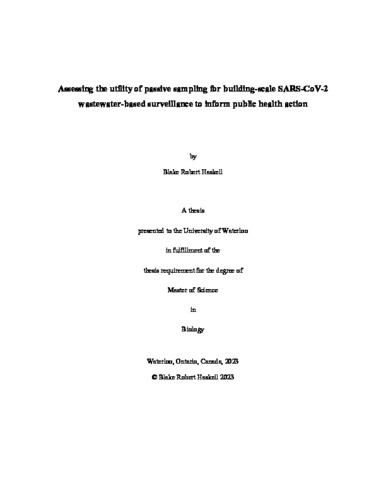| dc.description.abstract | Wastewater-based surveillance (WBS) is an effective public health tool that has been used to detect human viruses for decades. Most recently it has been applied to monitor SARS-CoV-2 RNA in municipal wastewater to track the prevalence and spread of COVID-19 in communities during the pandemic. Much of this work has been performed at the wastewater treatment plant (WWTP) prior to treatment, where it has been shown that WBS is closely related to clinical infections and hospitalizations. The application of WBS has gradually expanded to include upstream sites within the sewershed where neighbourhood and building-scale surveillance can be performed. However, sampling in these upstream environments introduces additional challenges for sampling and interpretation. The intermittent flow and composition of wastewater in the sewers close to the source greatly influences the variability and ability to accurately detect and quantitate the target viral fragments. One approach to circumvent some of these challenges is to employ a passive sampling approach where a chosen material is immersed in the sampled medium and left to passively accumulate a target analyte of interest over time. The sampling material is consistently exposed to the sampling environment which may reduce the likelihood of false negative detections. In this thesis, a two-tiered, trigger-based wastewater surveillance program was developed on the University of Waterloo (Waterloo, Ontario) campus residences during an active public health emergency (COVID-19 pandemic). The objective was to determine if WBS using passive sampling can be used to inform institution-level public health action.
Preliminary pilot studies validated a passive sampling method capable of detecting SARS-CoV-2 RNA in a municipal sewage system. Three candidate materials held in plastic frames (e.g., torpedo shaped perforated tubes) were tested for their efficacy in this application, including electronegative membrane filters and standard tampons. Cotton gauze was selected as the sampling medium for routine surveillance as it was able to detect the virus the most consistently and retained more suspended solids than the other materials tested. Twenty-four-hour passive samples were then collected three days per week over an eight-month surveillance period at selected utility holes associated with residences on the University of Waterloo campus. Two nucleocapsid gene targets (N1 and N2) of SARS-CoV-2 as well as the endogenous fecal indicator pepper mild mottle virus (PMMoV) were washed from the samplers, concentrated, extracted, and then quantified using real-time quantitative polymerase chain reaction (RT-qPCR). PMMoV is an endogenous indicator associated with human feces which has been used to normalize SARS-CoV-2 concentrations and account for dilution effects. The SARS-CoV-2 results were reported to the University health team in near real time (<12 h from sample collection). The developed workflow prioritized surveillance population coverage and minimal resource usage to address a variety of complex stakeholder needs and best support public health decision-making.
The period of the study included two contrasting exposure scenarios prior to and after the rapid emergence of the SARS-CoV-2 Omicron (B.1.1.529) variant. In the fall of 2021, community viral burden was low and a tiered sampling network was able to isolate individual clinical cases at the building-scale. In the winter of 2022 wastewater signals were quickly elevated by the emergence of the highly transmissible Omicron variant. The high prevalence of SARS-CoV-2 shifted surveillance objectives from isolating cases to monitoring trends. Throughout the surveillance period, comparisons between detection results and reported clinical cases revealed that passive samplers positively identified all but one of 203 infected individuals over eight months. In one instance surveillance led to the pre-symptomatic detection of a single individual at a site monitoring over 1300 students. WBS detected the infected individual two days in advance of clinical testing confirmation, demonstrating the efficacy of the tiered passive sampling approach in supporting public health action. Remarkably, SARS-CoV-2 concentrations on passive samplers were significantly correlated with confirmed clinical cases within the upstream sewershed. The strongest correlations were observed when clinical cases were assumed to have been shedding for 10 days from reporting illness. Additionally, comparisons between SARS-CoV-2 concentrations detected in campus sewers and in municipal wastewater influent suggest that the spread of COVID-19 on the campus was similar to that of the broader community. Periods of increasing and decreasing viral burden were captured at both sampling scales and closely mirrored each other in winter 2022. These results add to the mounting evidence that passive samplers are capable of producing semi-quantitative data that reflects the prevalence of disease within the sewer catchment. Alongside routine surveillance, methodological refinement occurred in parallel with routine surveillance efforts with the goal of maximizing data insight and actionability. This included routinely evaluating samples for evidence of RT-qPCR inhibition which saw a marked increase when students returned to campus and wastewater production increased. Modifications to the workflow were made to reduce inhibition and increase confidence in surveillance results. PMMoV concentrations on passive samplers were not reflective of upstream population differences and normalization of SARS-CoV-2 with PMMoV did not improve correlations with a clinical dataset. The results suggest that saturation of the material occurred during the exposure period thus limiting the utility of PMMoV as a normalizer to account for dilution effects.
This investigation demonstrates that passive sampling can be used as an effective tool to guide highly localized public health action. Spatially refined wastewater surveillance can support pandemic management decision making by acting as an early warning system, providing a basis for targeted health intervention and possible clinical testing, and is able to track spatiotemporal variations in viral RNA concentrations. The utility of a tiered surveillance approach described in this thesis demonstrates the importance of developing versatile methodologies that can be applied at varying spatial scales to address emerging public health challenges. | en |

